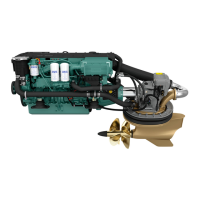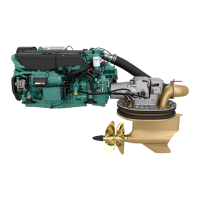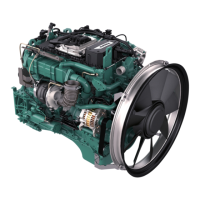Do you have a question about the Volvo Penta IPS 450 and is the answer not in the manual?
Safety precautions for operating the boat, including refueling and emergencies.
Safety guidelines for performing maintenance and service operations.
Environmental considerations and the engine running-in procedure.
Overview of IPS system benefits: efficiency, comfort, maneuverability, and installation.
Detailed technical description of the engine's components and systems.
Description of EVC system gauges, tachometer, and displays.
Operation of start/stop, EVC control, and docking station panels.
Navigating menus and functions within the EVC system.
Interpreting instrument readings and acknowledging alarms.
Recommendations for cruising, synchronizing engines, and steering.
Detailed operation of the joystick for precise boat maneuvering.
How to stop the engine and prepare the boat for storage.
Measures to prevent freezing damage during cold weather.
Summary of maintenance tasks by frequency: daily, 14-day, and interval.
Engine inspection, changing air and crankcase ventilation filters.
Maintenance of engine oil, filters, freshwater, and seawater cooling systems.
Maintenance of fuel filters, bleeding fuel system, and electrical system checks.
Maintenance of the drive-unit oil, corrosion protection, and propellers.
Procedures for inhibiting the engine and systems for storage.
Checks and procedures for bringing the boat out of storage.
Starting with auxiliary batteries and emergency drive-unit shifting.
Identifying and diagnosing engine and system faults.
Understanding malfunction messages and using the fault register.
Technical data for engines, fluids, and drive-units.
Safety precautions for operating the boat, including refueling and emergencies.
Safety guidelines for performing maintenance and service operations.
Environmental considerations and the engine running-in procedure.
Overview of IPS system benefits: efficiency, comfort, maneuverability, and installation.
Detailed technical description of the engine's components and systems.
Description of EVC system gauges, tachometer, and displays.
Operation of start/stop, EVC control, and docking station panels.
Navigating menus and functions within the EVC system.
Interpreting instrument readings and acknowledging alarms.
Recommendations for cruising, synchronizing engines, and steering.
Detailed operation of the joystick for precise boat maneuvering.
How to stop the engine and prepare the boat for storage.
Measures to prevent freezing damage during cold weather.
Summary of maintenance tasks by frequency: daily, 14-day, and interval.
Engine inspection, changing air and crankcase ventilation filters.
Maintenance of engine oil, filters, freshwater, and seawater cooling systems.
Maintenance of fuel filters, bleeding fuel system, and electrical system checks.
Maintenance of the drive-unit oil, corrosion protection, and propellers.
Procedures for inhibiting the engine and systems for storage.
Checks and procedures for bringing the boat out of storage.
Starting with auxiliary batteries and emergency drive-unit shifting.
Identifying and diagnosing engine and system faults.
Understanding malfunction messages and using the fault register.
Technical data for engines, fluids, and drive-units.
| Type | Inboard |
|---|---|
| Power Output | 450 hp |
| Displacement | 5.5 L |
| Number of Cylinders | 6 |
| Fuel System | Common rail |
| Weight | 440 kg |
| Aspiration | Turbocharged |
| Fuel Type | Diesel |
| Engine Type | Diesel |
| Max RPM | 3500 |
| Emissions Compliance | EPA Tier 3 |











